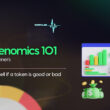Technocracy is often associated with tyranny, and while this is not always the case, there are reasons.
This article does not intend to do futurology, but rather to present an outline of the potential of three technologies, which combined will surely have a disruptive synergy, which could first give great power to governments run by people, and then to those run by self-sufficient autonomous algorithms.
Richard Buckminster Fuller, American architect, philosopher and futurist writer, said: “Humanity is acquiring all the right technology for all the wrong reasons”.
The term “Technocracy” derives from the Greek words “tekhne”, meaning skill, and “kratos”, meaning power or government.
The concept of Technocracy dates back to the early 20th century in the United States, and that idea gave rise to a popular movement during the Great Depression. The movement was founded by individuals who proposed replacing government politicians with technocrats, such as scientists and engineers, who were believed to have the necessary skills to solve the problems that afflicted the world.
In traditional democracy, leaders are chosen based on their popularity, whereas to serve in Technocracy, technocrats must possess demonstrated knowledge and relevant skills in their field of expertise, rather than gaining popularity based on their political affiliations.
In practice, Technocracy can be distributed across the executive branch of government, as well as non-governmental institutions that help technocrats develop, advocate, and execute policy.
The central idea of Technocracy is that political decision-making is “depoliticized” for reasons of efficiency and isolated from the democratic process. This may raise concerns about the dominance of elites with a tendency towards the concentration of power, towards authoritarianism, and the erosion of liberal democracy.
In some countries, technocratic governments have been formed, in which ministers are not career politicians, but experts in their respective fields. For example, Italy and Greece have had technocratic governments led by economists in times of crisis, or the most emblematic case, China, which I will explain later.
Growing technologies are shaping 21st century society: Artificial Intelligence (AI), the Internet of Things (IoT) and Blockchain.
Three Technologies That Will Change The World
The Information Age is the historical period that began in the mid-20th century, and is characterized by a rapid shift from traditional industries to an economy focused on information technology.
The beginning of electronic computing had important advances with the development of the transistor in 1947 and the appearance of Unix in 1970.
In the 1960s, as a means for government researchers to share information, ARPANET was developed and eventually evolved into the Internet. The official date of birth of the Internet is considered to be January 1, 1983, when ARPANET and the Defense Data Network officially switched to the TCP/IP standard, allowing different types of computers on different networks to “talk” to each other.
As of November 2023, the world’s fastest Internet is being developed in China, with a speed of 1.2 terabits per second (Tbps), which can transmit data equivalent to 150 high-definition movies in just one second. This network, which covers more than 3,000 km of fiber optic cabling and links Beijing, Wuhan and Guangzhou, is part of the Future Internet Technology Infrastructure (FITI) de China, is a collaborative development between Tsinghua University, China Mobile, Huawei Technologies and Cernet Corporation, but is not yet available to the general public.
On this technological basis, the three technologies that, for me, will change the world are developed: AI, IoT and Blockchain.
I will briefly explain each one, just to understand them, since the focus of this article is not to delve into their technology, but rather into their social and economic implications.
Artificial Intelligence (AI) is a development based on self-management computer programs, which simulate human intelligence processes by machines, with evolutionary iteration applications of Machine Learning and Deep Learning.
The Internet of Things (IoT) is a network of physical electronic devices, or “things”, equipped with sensors, software and other technologies that allow them to connect and exchange data with other devices and systems through the Internet, or other communications networks. , to perform various tasks autonomously. These “objects” can range from simple smart home devices, such as thermostats and appliances, to complex industrial machines and transportation systems.
Blockchain technology is based on Distributed Ledger Technology (DLT), an infrastructure that allows access, validation and simultaneous updating of records through a network of connected nodes, with decentralization in the production of information being a key concept for the Blockchain.
Now, knowing these three technologies, and although each one has its own evolution and varied application, imagine the potential of all three combined. Let’s see.
Technological Synergy
Blockchain networks act as secure mechanisms in which transactions are stored without a central point of failure, a product of decentralization in the production of information.
The Blockchain can record all this data, and be the vehicle for the information produced.
Smart contract technology, which contains AI, can allow more complex self-executing procedures, which in turn learn from input/output with Machine Learning protocols, which means that it would be an “intelligent” Blockchain and, the more time passes, the more autonomous.
Blockchains can only store and validate the data they receive, and that is why the accuracy of the information on the Blockchain depends on the reliability of its sources and their security, since the data is subject to attacks and hacks. For example, a malicious party could attempt to alter data coming from an IoT device.
Although the 3 technologies meet objectives from their own functionalities, it is inevitable to integrate them when seeking maximum efficiency and security.
Even when smart data is collected by AI algorithms and combined with reliable data transmitted through IoT sensors, security is questionable. This is where Blockchain comes into the equation as a decentralized and transparent transaction ledger.
Then we have the IoT that takes data from physical reality, stores it in the Blockchain, and this with smart contracts managed with AI, processes the data to obtain information, and then decides an action based on it, ordering the execution with IoT, closing the technological circuit. It could be something like this:

For example, in a shipment of goods that needs refrigeration, its route can be tracked and traced with transactions on the Blockchain. An IoT device sends the temperature information to be stored in the network. This method is similar to that used by Blockchain oracles, Chainlink being the best known. If the temperature of the goods deviates from the established range, a smart contract could generate alerts and if the temperature is not restored within a certain time, actions could be taken, for example, activating an emergency equipment located in the transport, connected to an IoT device. This technology, which sounds like science fiction, was applied in a not-so-sophisticated way by IBM’s TradeLens Shipping Solution, and Maersk applied a similar supply chain concept in recent pilot projects.
Another case is the health industry, using private Blockchain networks, in which patients’ health data collected through body signals can be recorded and controlled, with devices on the patients’ bodies and connected to the internet, with reliability of information for all health institutions in the system. The integration of AI procedures could trigger actions, such as notifying the doctor and patient of possible medical implications based on identified patterns.
Let’s imagine that a farmer signs an insurance contract with an insurance company, and it monitors rainfall to compensate clients in the event of a flood. The records are on the Blockchain. The insurance company will compensate the farmer in the event that rainfall exceeds a certain amount of millimeters. What if the insurance company or the farmer himself tries to hack the IoT sensor and alter its metrics to their benefit? The Blockchain network considers the data from the IoT device legitimate, even if someone compromises the measurement. Unless there was a smart contract with AI to audit the data, validating the information with other sources.
Digital identity plays a key role, as users can control what data they share and who has access to it. This feature is essential for ecosystems that require digital identities and security of sensitive data, such as the healthcare industry.
For this synergistic integration, the scalability and interoperability of Blockchain networks remains an obstacle. Scaling with sidechains is raised as a solution, but there is debate in the community whether it is secure or not, because of its lack of decentralization.
A Future Of Technocratic Tyranny? The Laboratory In China
The People’s Republic of China currently has the most developed technocracy in the world. Although, politically, the Communist Party holds power, the important thing here is to understand the technocratic structure, beyond the political format.
Mass surveillance in China emerged in the Maoist era, after the creation of the People’s Republic of China in 1949. Mao invented a mechanism of control over his citizens to reinforce his power in the nascent government.
Since 1978, more and more technical experts have become part of the Chinese government, creating a growing technocracy. Mass surveillance in the country is the most developed network of global surveillance systems used by the Chinese central government to monitor citizens, through the Internet, surveillance cameras and other digital technologies, which has become increasingly widespread and sophisticated. under the administration of Xi Jinping, general secretary of the Chinese Communist Party.
Much is made of the Chinese social credit system, which gives its citizens a numerical score by analyzing their social behaviors and collecting tax and government data, and consequently punishes and rewards them with that score, and beyond the effectiveness of its control due to its technology still in development, and exaggerated by its state propaganda, the important thing is to understand that the control decision exists, and all that remains is to evolve the environment.
Final Words
In my opinion, the three technologies that I mentioned will only evolve, and I do not see any possibility of them being discontinued, since each one has great potential and there are vested interests for its development.
I also believe that the combination of them is inevitable, in different developments with different uses, because the complement that they offer between them is natural. I think this was clear in the examples I presented.
Although they are useful to improve people’s quality of life, I also believe that (many of) governments (and big tech) will abuse this technological synergy to preserve and grow their power, their Status Quo.
But there is a second issue, and that is that technology evolves to the point of its autonomy, exercising control of information and making self-sufficient decisions, having control over energy, communications, financial systems, and even food production.
The two sides of the same coin, where technological evolution benefits on the one hand, and at the same time harms on the other, the quality of life and freedom of people.
Science fiction exists based on imagination, and technological innovation too.










